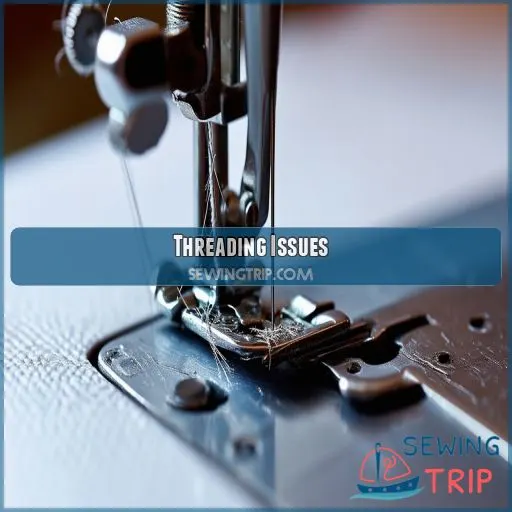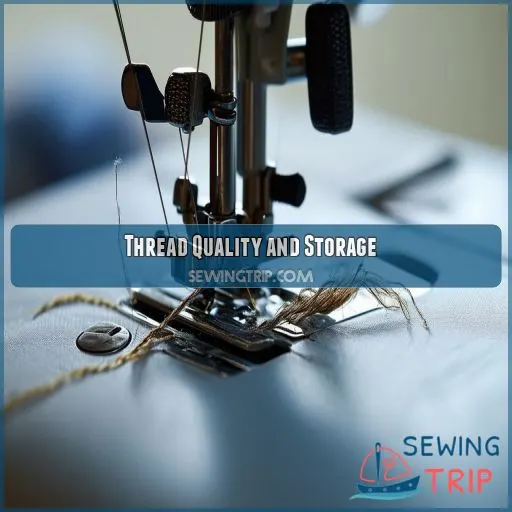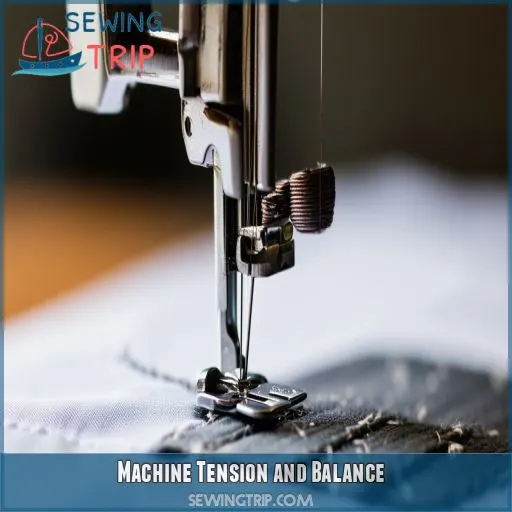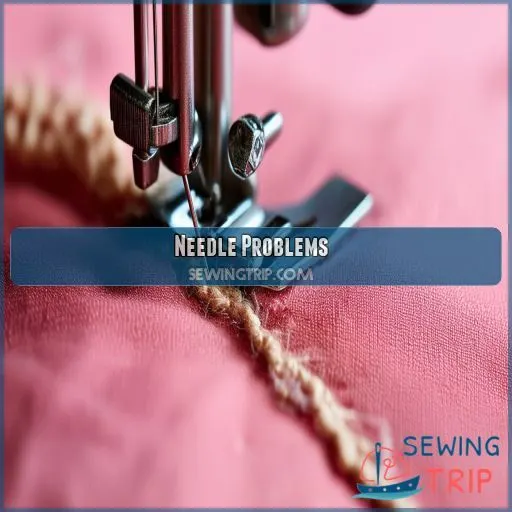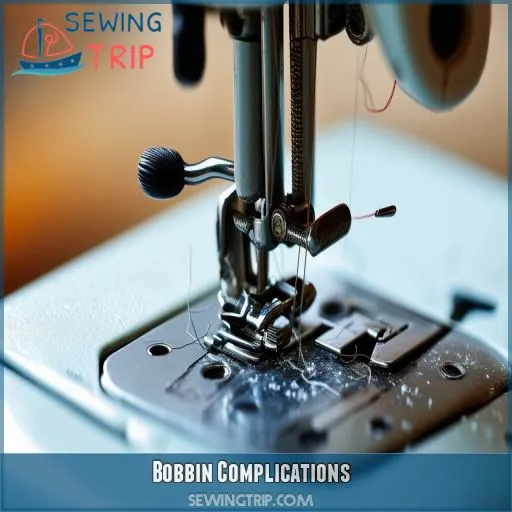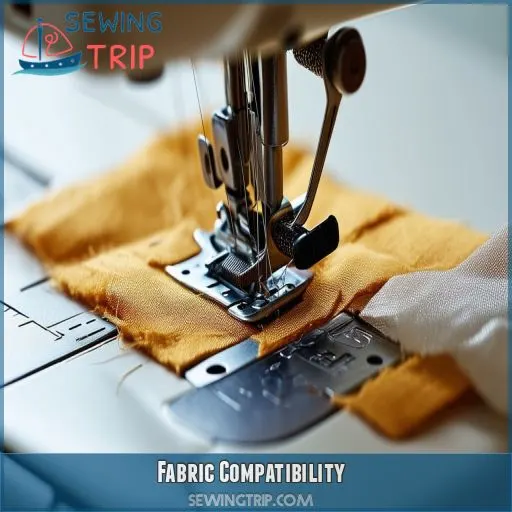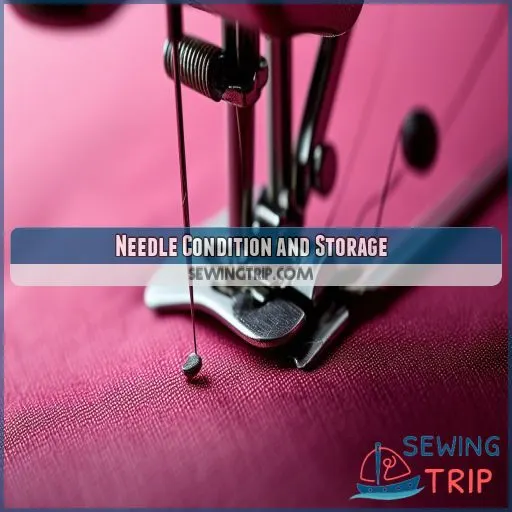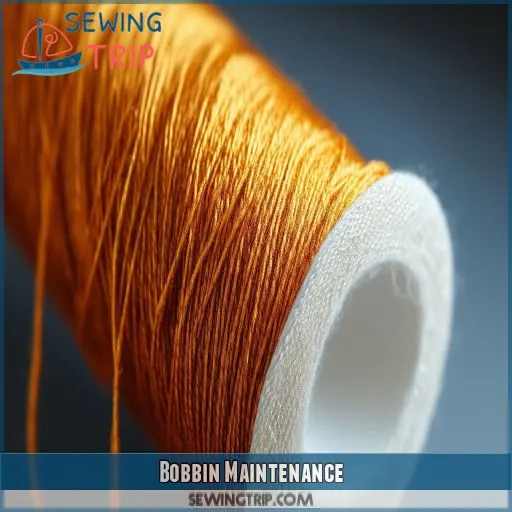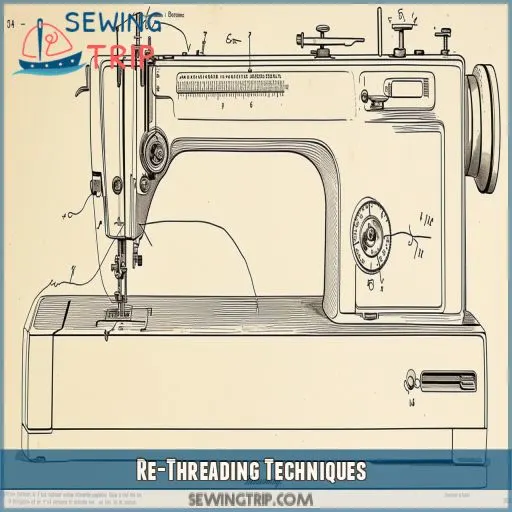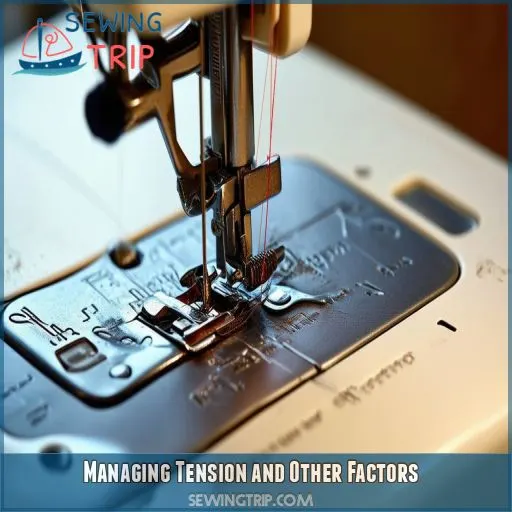This site is supported by our readers. We may earn a commission, at no cost to you, if you purchase through links.
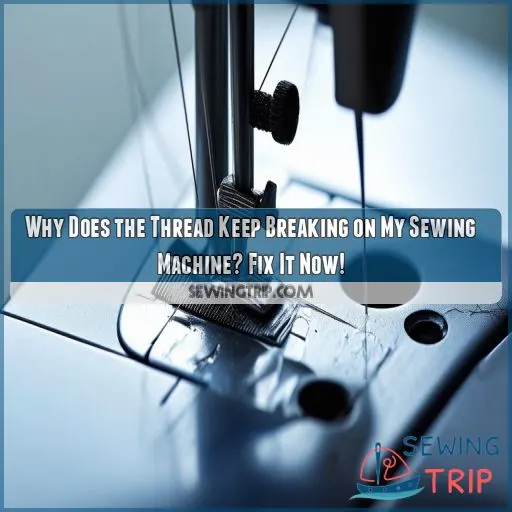
This article will help you figure out why your thread’s always breaking and how to fix it fast. We’ll cover common problems with threading mistakes, bad quality threads, tension problems within the machine itself, and so forth. Each section includes precise steps to be taken in order for one to have their machine running once more with no hassle.
Dive into mastering these solutions, and regain control over your sewing projects.
Table Of Contents
- Key Takeaways
- Why Does the Thread Keep Breaking on My Sewing Machine?
- Threading Issues
- Thread Quality and Storage
- Machine Tension and Balance
- Needle Problems
- Bobbin Complications
- Fabric Compatibility
- Needle Condition and Storage
- Bobbin Maintenance
- Re-Threading Techniques
- Managing Tension and Other Factors
- Frequently Asked Questions (FAQs)
- Conclusion
Key Takeaways
- Thread breaks are like unwanted guests at a party – they spoil the fun! Check your threading, thread quality, and machine tension to send them packing.
- Your sewing machine is like a picky eater – it needs the right needle, bobbin, and fabric combo to perform its best. Make sure they’re all compatible, and you’ll avoid thread-snapping tantrums.
- Regular maintenance is like giving your sewing machine a spa day – it keeps it running smoothly and prevents thread-breaking meltdowns. Clean it regularly, and you’ll be rewarded with happy stitches.
- If all else fails, don’t be afraid to ask for help. There’s always a sewing guru out there who can help you troubleshoot and get your machine back on track.
Why Does the Thread Keep Breaking on My Sewing Machine?
If the thread keeps breaking on your sewing machine, then surely there are some common issues.
First of all, verify that the threading is correct on the sewing machine and check the tension of the thread.
The quality of thread could also be a culprit; steer clear of old or frayed threads. Keep your needle in good condition by replacing it if bent and choosing the right size for your fabric.
First, check that the bobbin is seated properly and that the proper tension setting for your fabric is set.
These simple checks often correct the problem; stick around to find more solutions that might just save your project.
Threading Issues
First and foremost, one of the common culprits responsible for thread breaks is an incorrectly threaded machine. Check first to make sure that your machine is threaded correctly. Verify that the thread follows the correct path and passes through all necessary guides.
Keep an eye on tension troubleshooting; misaligned tension will have you breaking frequently. Check for incorrect needle placement. If your needle isn’t correctly inserted, its thread will catch and snap. This may also occur due to a worn-out needle or accumulation of fluff around the circumference of the needle plate. You need to clean these areas periodically. The needle mustn’t hit the presser foot or any portion of the needle plate.
Most sewing issues are the result of improper threading of your sewing machine and poor maintenance of its parts. This should be checked for smooth, glitch-free sewing.
Thread Quality and Storage
Thread quality and storage play a significant role in preventing thread breaks. It is crucial to always use good-quality thread that suits the nature of your fabric. Avoid using low-cost, old, or frayed threads as they are prone to snapping and snagging.
Store your threads in a cool and dry place to maintain their durability and prevent them from becoming fragile or weak. Keep spools conveniently stored in a container or drawer that protects them from dust and sunlight.
Ensure you use the correct type and size of thread for your project by referring to the specifications on the spool. Wind the thread neither too tight nor too loose, as improper tension can lead to thread breakage.
Machine Tension and Balance
It is important to have proper tension and balance of the machine, which will ensure smooth sewing. If the settings are misaligned, then quite possibly it may result in thread breakage. Here’s what you need to check:
- Tension Adjustments: Set tension for evenly formed stitches. Scrap fabric will be needed to test on and make adjustments if necessary.
- Spool Placement: Provided that the spool wasn’t placed appropriately, it can finally lead to uneven flow in your thread. Ensure that it’s properly positioned.
- Presser Foot Pressure: Loosening the presser foot tension will keep control over the fabric as it feeds and will work to prevent skipped stitches.
- Thread Guides: Verify that the thread runs smoothly through all guides and doesn’t snag.
This can also be due to the lint under the throat plate or around the bobbin area. Adequate lubrication of the needle may also reduce the friction and thus not cause thread problems.
Needle Problems
Sometimes, issues related to the needle can be a fault when the sewing machine thread keeps breaking. Be sure that the correct size needle is employed for the textile to be sewn.
Since a bent needle will surely pick on the bad habit of improper stitches and thread breakage, replace it quickly.
Different kinds of needles are required for different fabrics; thus, picking the wrong one may cause this problem.
Also, more lubricated needles reduce the friction that might lead to the snap of the thread.
Also, pay regard to the needle-fabric compatibility, as there are certain fabrics that require special needles.
Your problems will surely be present if your needle size isn’t in agreement with your thread and fabric.
Last but not least, insert your needle correctly, as even a slight tilt will change your stitch width and result in breakages again and again.
Taking regard for these factors related to needles can enhance your sewing to a much greater extent.
Bobbin Complications
If your thread keeps on breaking, this may be due to issues with the bobbin. Check that the bobbin is seated properly inside the bobbin case and that there are no gaps between them. Take a look at your bobbin winding—it should be even and tight. Thread mustn’t be loose or unevenly wound around the bobbin. The wrong tension of threads on the bobbin will cause the threads to break; hence, adjust accordingly.
Be sure you’re using the right kind of bobbin for your machine. A wrong size or style may raise havoc. Store bobbins in a dry place to prevent thread from becoming damaged or frayed. Doing only this very minor maintenance with your bobbins will get those annoying thread breaks under control in no time. Happy sewing!
Fabric Compatibility
Choosing Correct Materials Avoiding thread breakage is important, and the right choice of fabric will prevent this problem. Carefully consider the weight and texture of your fabric for compatibility with your chosen thread and needle. Always:
- Select the correct needle size: Heavy fabrics, such as denim, have a larger needle size.
- Use specialty needles: Because occasionally, some fabrics may require specialty needles, such as an upholstery needle for thick or textured materials.
- Thread type matching: Heavy-duty fabrics demand strong threads like upholstery threads to match what the fabric is going to do.
- Test stitch settings: Before you get busy, sew a little on scrap to get the tension and settings right.
Otherwise, using the wrong combination will cause excess friction and break threads too often. Make sure everything lines up for easy stitching and fewer headaches.
Needle Condition and Storage
Keep your sewing machine needle in good condition. If it’s bent or damaged in any way, you can expect to have thread breakage. Turn the needle over on a regular basis and replace it if there are any indications of wear. Use a needle designed for the kind of fabric you’re using to help stop problems.
| Problem | Symptom | Solution |
|---|---|---|
| Needle damage | Skipped stitches | Replace the needle |
| Bent needle | Irregular stitches, thread obvious breakage | Use a straight new needle |
| Storage of Needles | Not able to find the right needle | Store needles in a safe container |
Store needles safely to prevent them from bending or any other damage. If you sew a lot on specific fabrics, you may want to see specialty needles.
Bobbin Maintenance
Proper care of the bobbin will prevent thread breaks. First, wind the bobbins evenly and tightly to avoid tangling.
If the bobbin isn’t inserted properly, it can result in various problems; hence, ensure that it’s correctly seated inside the bobbin case.
Check for proper tension of the bobbin thread; too little or too much tension in the bobbin thread can cause it to break.
Clean the bobbin case periodically to remove lint and fluff that may accumulate and hamper the smooth flow of thread.
The proper bobbin types for your machine are a must; mismatched bobbins will mess up your sewing.
Besides, keeping the area of the bobbin clean and properly serviced will keep your sewing running as smoothly as a well-oiled machine. Just remember, paying a little attention to these details will significantly improve the way one sews.
Re-Threading Techniques
One of the most common and frequent occurrences is miss-threading. You’ll save yourself a lot of hassles by simply re-threading your machine properly. First, start with turning off the machine to avoid any kinds of possible accidents, after which refer to your re-threading instruction manual that originally came with the machine.
Be very particular about the threading sequence. Take care that the thread passes through every guide, take-up lever, and tension disk. Check for common re-threading mistakes such as a missing guide or one path threaded wrong. Sometimes, looking at a re-threading diagram will give you the right path.
Start threading; keep the presser foot raised so all thread is seated properly through tension disks. Don’t hurry, because careful threading will save you from problems later during the sewing process. A properly re-threaded machine leads to smooth, uninterruptible sewing.
Managing Tension and Other Factors
Adjusting the thread tension ensures your stitches are balanced and prevents breakage. Correct needle insertion and regular lint removal also play key roles in maintaining smooth sewing operation.
Adjusting Thread Tension
This will avoid thread breakage simply by adjusting the thread tension.
First, check for your machine’s tension settings. More often than not, adjustments to tension resolve irregularity between the top and bobbin threads.
Test your stitches for tension balance on scrap fabric.
If it reveals a problem with tension troubleshooting, adjust the dial to get the right tightness, and there will be no thread snapping at all.
Correct Needle Insertion
Insert your needle correctly to avoid thread breakage.
Check on the length of the needle; it has to be long enough to reach the bobbin.
Check if the needle is blunt or sharp, change the needle if it’s blunt.
Choose the correct type and size of the needle for your fabric.
The eye of the needle should accommodate your thread size.
Preventing Lint Buildup
Clean the bobbin case, tension disks, and needle bar of lint regularly with a small brush or compressed air to prevent an accumulation of lint.
Check for stray lint and blockages in the thread guides.
Good sewing machine maintenance allows your machine to operate smoothly.
Make sure the tension is properly set and evenly balanced and the bobbin tension property set in order to avoid thread breaks and uneven stitches during sewing.
Frequently Asked Questions (FAQs)
What is the remedy when the upper thread breaks?
Check that the top thread is correctly installed and that there’s proper tension on it, as things can go wrong with the installation of your needle or the needle itself gets damaged. Remove any accumulation of lint and use quality threads appropriate for your machine and fabric.
What tension should my sewing machine be on?
Keep your sewing machine tension between 4-5 if you’re working with regular fabrics. Keep in mind that the adjustment will depend on the kind of fabric or thread used. Always test on scrap for even stitches.
How do you prevent thread breaks?
Like a well-tuned symphony, preventing thread breaks means maintaining correct tension, using high-quality, compatible thread, ensuring proper needle insertion, and keeping your machine clean of lint. Regularly check for damaged components to avoid disruptions.
Why does my sewing machine thread keep coming out?
Your sewing machine thread keeps coming out because it’s threaded incorrectly, has the wrong tension set, or your needle is damaged. To fix this problem, make sure it’s threaded correctly, then adjust the tension and check your needle for bends or damage.
How to fix skipped stitches in seams?
To fix skipped stitches, check needle type and condition. Ensure proper needle size for the fabric, re-thread the machine completely, adjust tension settings, and inspect for any lint buildup in the bobbin area.
What causes loops on the bottom side?
A stitch in time saves nine. The loops which happen on the underside of your fabric are most times caused by incorrect top thread tension, threading improperly, or even using the wrong type of needle. Ensure correct machine threading and tension settings.
How to identify sewing machine timing issues?
You can identify sewing machine timing issues by inspecting for unaligned needle position, skipped stitches, and uneven stitches. Listen for unusual noises and check if the needle meets the bobbin hook accurately during the stitch formation process.
Why does my machine jam intermittently?
Isn’t that maddening when your machine has jammed? Intermittent jamming is normally caused by lint buildup, mis-threading, or incorrect tension adjustments. Regular cleaning and correct threading prevent jamming and assure even stitching.
How to properly clean the feed dogs?
Properly clean the feed dogs—gently sweep off all built-up lint or other debris with a small brush or shot of compressed air. Make sure the feed dogs can move freely; then there won’t be any obstruction for easy fabric feeding.
Conclusion
All things considered, fixing your sewing machine issues doesn’t have to be a needle in a haystack.
When wondering "why does the thread keep breaking on my sewing machine," checking threading, thread quality, and machine tension is key.
Pay attention to the needle, bobbin, and fabric compatibility.
Regularly maintain your machine, ensuring it’s clean and correctly threaded.
Following these steps will keep your projects seamless, letting you enjoy sewing without interruptions.
Master these solutions and keep sewing smoothly.

